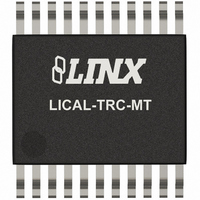LICAL-TRC-MT Linx Technologies Inc, LICAL-TRC-MT Datasheet - Page 5

LICAL-TRC-MT
Manufacturer Part Number
LICAL-TRC-MT
Description
IC TRANSCODER MT BI-DIR 20-SSOP
Manufacturer
Linx Technologies Inc
Series
MTr
Type
Transcoderr
Specifications of LICAL-TRC-MT
Package / Case
20-SSOP
Applications
RF, IR
Mounting Type
Surface Mount
Supply Voltage (max)
5.5 V
Supply Voltage (min)
2 V
Maximum Operating Temperature
+ 85 C
Minimum Operating Temperature
- 40 C
Mounting Style
SMD/SMT
Lead Free Status / RoHS Status
Lead free / RoHS Compliant
Lead Free Status / RoHS Status
Lead free / RoHS Compliant, Lead free / RoHS Compliant
Other names
LICAL-TRC-MTTR
Available stocks
Company
Part Number
Manufacturer
Quantity
Price
TRANSCODER OPERATION
Page 8
• Prior to Create Mode, all of the status lines will be either inputs or outputs
• Prior to Learn Mode, any valid MS or MT style packet will activate the status line
When the transcoder powers on for the first time, it is in a default set-up. When
in this mode, the transcoder looks at the state of the ENC_SEL line on power-
up. If the line is high, then the transcoder enters Default Encoder Mode and acts
like an encoder only. It pulls the TR_SEL line high to set the transceiver into
transmit mode and makes all of its status lines inputs. It will use a default
address that is set at the factory.
If the ENC_SEL line is low, then the transcoder enters Default Decoder Mode
and acts like a decoder only. It pulls the TR_SEL line low to set the transceiver
into receive mode and makes all of its status lines outputs. At this point, the User
Access is open, so the transcoder accepts all valid transmissions, regardless of
address. This allows the designer to set up an external database for learned
users and control permissions. The designer is free to set up a system of their
choosing. External parts can be used with the transcoder to give the end product
more memory to increase the number of users and more processing speed have
a faster response time when scanning through the user list. In this mode, the
transcoders become a data pipe around which a designer can create a larger,
more complicated system than can be implemented with the transcoders alone.
The User Access can be locked simply by learning a user. From this point on, it
requires that the transmission have a valid, learned address before it will
respond. Only a Restore Default commend sent on the serial interface will place
the transcoder back into Default Decoder Mode. This command removes all
existing settings and restores the transcoder to the factory default condition.
Once an address has been created, the transcoder enters a Defined set-up. The
state of the ENC_SEL on power-up also determines the mode of operation in this
set-up. If the ENC_SEL line is high, the transcoder enters Defined Encoder
Mode. The process of creating an address also defines which status lines are
inputs and which are outputs. In this mode, the transcoder acts as an encoder
only using just the defined inputs and the address that was created.
If the ENC_SEL line is low, the transcoder enters Transcoder Mode and uses
both the inputs and outputs as well as the defined address. In this mode, it can
send commands as well as receive commands. As above, the User Access is
open until a user is learned into memory.
Table 2 shows the different modes and how they are entered.
If the transcoder has been previously set up, through creating an address and
learning users, then the saved settings are applied and the transcoder enters the
appropriate mode based on the state of the ENC_SEL line.
The transcoder then sets the baud rate according to the state of the SEL_BAUD
line and goes to sleep until an action on one of its inputs places it into another
mode.
In summary, there are two key points in the initial operation of the transcoders:
depending on the state of the ENC_SEL line when the transcoder is powered
on.
outputs.
Page 9






















